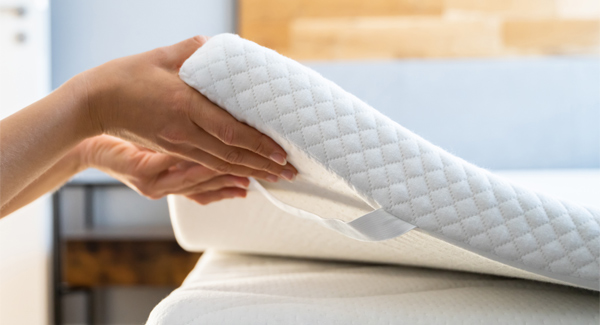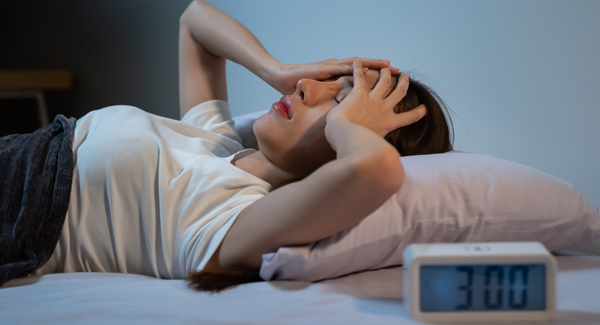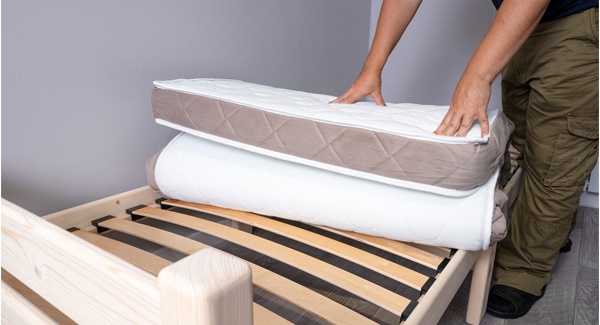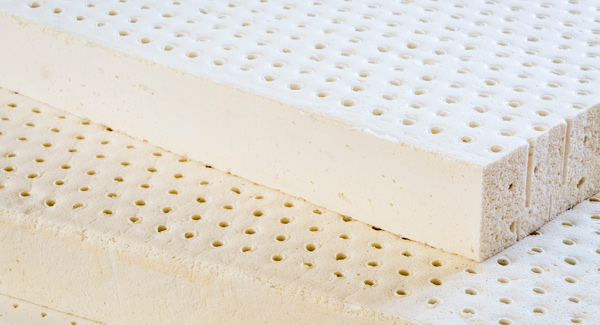Home » Mattress types » Is Memory Foam Good For Your Back?
Is memory foam good for your back?
Article navigation
- Published:
- Written by: Tony Brown
- Topic: Mattress types
Memory foam is a popular mattress material that can help prevent back pain and pressure points. It is primarily made of polyurethane and other chemicals. Memory foam gently moulds to the shape of the body and gradually returns to its original shape when pressure is removed.
The material was originally developed under a NASA contract to help cushion astronauts during flights. Scientists and engineers developed a viscoelastic material that can absorb energy and relieve pressure.
Following further development, memory foam was later used in healthcare settings to improve patient comfort and then for widespread commercial use in mattresses and pillows.
But is a memory foam mattress good for your back? Here’s what you need to know.
Is memory foam suitable for everyone?
First and foremost, there’s no one size fits all approach to mattresses. Your weight, height, build, sleeping position, budget, and personal preference affect which type of mattress you may need.
However, sleeping on a mattress that does not correctly support the body can exacerbate back pain and contribute to poor-quality sleep. Therefore, it’s important to choose a mattress that you find comfortable and supportive.
Memory foam mattresses are constructed with different layers of foam, which vary in thickness and density. The layer construction will differ from one mattress to another but will typically consist of the following:
- A durable bottom layer which is usually deeper and firmer for stability.
- A middle layer to ensure the body is aligned and correctly supported.
- A top comfort layer which moulds and adapts to the body.
The ability of memory foam to adapt to body shape and provide crucial support ensures it is suitable for all sleeping positions. Memory foam is particularly beneficial for side sleepers because of its softer cushioning layers.
Some memory foam mattresses have an open cellular structure consisting of tiny air pockets that improve the airflow and allow the material to adapt to body shape.
Mattress firmness
Memory foam comes in different firmness levels, affecting how the mattress feels and performs. Choosing the correct firmness is essential to allow the material to conform to the body and provide proper support.
A mattress that is too firm will not conform effectively to the body. The body will simply rest on top of the mattress. In contrast, a mattress that is too soft will allow the body to sink too far into the mattress, putting the spine out of alignment.
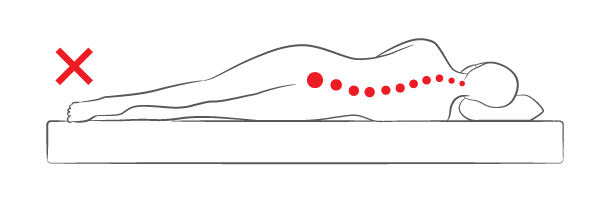
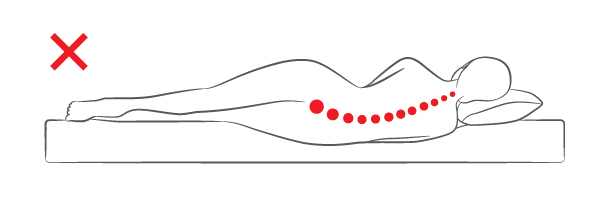
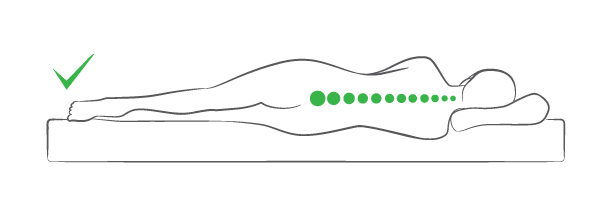
Though mattress comfort often comes down to personal preference, correct support depends primarily on your body weight. Generally, the heavier you are, the firmer the mattress you need.
What are the advantages of memory foam?
Memory foam mattresses share similar characteristics, but quality and performance can vary from one model to the next. Memory foam’s most significant advantage is its ability to relieve pressure, but there are additional factors to consider.
Pressure-relief
Memory foam conforms more closely to the body than other materials, creating a hugging sensation.
Unlike sprung mattresses which can cause painful pressure points, most notably on your back, shoulders, and hips, memory foam distributes body weight evenly, providing effective pressure relief.
The pressure relief provided by memory foam can help alleviate aches and pains and improve blood circulation.
It’s worth noting that as there are different qualities of memory foam, cheaper mattresses may be less effective at relieving pain and pressure.
Reduced tossing and turning
Tossing and turning is often the result of an uncomfortable mattress causing numbness or pain in certain areas of the body. Memory foam’s pressure-relieving capabilities help alleviate discomfort and reduce tossing and turning in bed.
Promotes spinal alignment
Memory foam evenly distributes weight and pressure across the entire mattress surface, promoting good spinal alignment.
Motion isolation
Partner disturbance can contribute to poor-quality sleep. Memory foam naturally absorbs movement, meaning that sleeping partners are less likely to disturb each other in bed.
Hypoallergenic
Memory foam mattresses are typically hypoallergenic and resistant to dust mites, mould, and mildew, making them ideal for asthma and allergy sufferers.
Quiet in use
Memory foam is also quiet in use. There are no squeaky springs or components keeping you or your partner awake at night.
Low maintenance
Memory foam is a durable material that slowly returns to its original shape when weight is removed. As a result, memory foam mattresses do not require turning like traditional sprung mattresses. No heavy lifting is involved because you can only sleep on the top side of the mattress. You can’t flip the mattress over, but you can occasionally rotate it from head to toe if you prefer instead.
What are the drawbacks of memory foam?
Memory foam mattresses are renowned for providing effective pressure relief and optimal support, but memory foam also has some drawbacks because of its structure.
Sinking issues
One of the downsides to memory foam is that it has little to no resiliency compared to other types of mattresses.
Memory foam is a temperature-sensitive material that responds and reacts to body heat. The material gets softer the longer you lie on it. The slow recovery can sometimes make you feel ‘stuck’ in the mattress, making it harder to turn over in bed. Heavier people, in particular, may find memory foam uncomfortable because they sink too far into the mattress.
Heat retention
A common concern with memory foam is heat retention. Memory foam’s dense cell structure makes it less breathable than other materials. It also closely conforms to the shape of the body, trapping more heat within the mattress. As a result, some people may feel warmer sleeping on memory foam.
Though manufacturers have introduced ways to address these issues through breathable covers and materials, those that are heat sensitive may prefer to avoid memory foam.
Memory foam smell
It’s not uncommon for memory foam mattresses to have an unpleasant smell or odour when unpacked. This is referred to as off-gassing. The smell is perfectly normal and should dissipate within a few weeks. However, allowing the mattress to breathe in a well-ventilated room may help to eradicate the smell sooner.
Weight
Memory foam mattresses are notoriously heavy and difficult to move. Fortunately, most memory foam mattresses do not require turning, therefore keeping physical effort to a minimum.
What are the alternatives to memory foam?
Memory foam can feel quite different to other materials. If you’re unsure whether the material is right for you, several alternatives are available.
Hybrid
Before ruling out memory foam completely, consider a hybrid mattress that typically combines foams with springs. Hybrid mattresses offer the perfect compromise for those that prefer the support of springs with the cushioning and pressure-relieving benefits of memory foam.
Latex
Latex and memory foam share similar characteristics, but while memory foam has a delayed recovery, latex has a slightly bouncier feel and responds almost immediately. Like memory foam, latex conforms and adapts to the body. It offers excellent pressure relief and distributes body weight evenly across its surface.
Pocket springs
Pocket springs offer a good alternative to those who prefer the feel of a sprung mattress. Each spring in a pocket spring mattress moves independently, ensuring the body is correctly supported.
Pocket springs are smaller, softer springs that conform well to body shape and distribute pressure evenly. Since each spring is independent, pocket springs absorb movement, ensuring sleeping partners are less likely to disturb one another.
Final thoughts
Almost every mattress brand promises their products can prevent or relieve back pain, but some will be more effective than others. Just remember to carry out plenty of research beforehand to ensure the mattress you buy is everything it claims to be.
Learn more
Share this article

About the author
Tony Brown is the founder and creator of The Bed Consultant. His career in the bed industry began in 2002. After graduating from university with a degree in Business Administration, Tony joined one of the largest independent furniture retailers in the UK as a bed consultant. Tony has helped thousands of customers find the perfect mattress.


